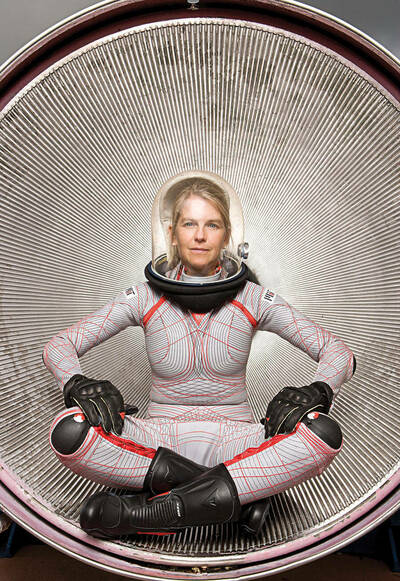In retrospect, it makes sense that Dava Newman ’86 grew up in what’s called “Big Sky Country.”
Not only because the aerospace biomedical engineer has built a career on the innovations needed to explore the stars that shine brightly over her native Montana. But also because of the scale of her ambition and her confidence that human cooperation and ingenuity have all the potential — today, right now — to land human beings on Mars and address the ravages of climate change on Earth.
Her daily task? “To reach human potential,” she says. “Reaching for that audacious, almost impossible goal.”
Newman has spent the last two years as director of the MIT Media Lab, a legendary interdisciplinary research unit that fosters freethinking collaboration between faculty and students on everything from robotics and computer programming to music and smart prostheses.
Praised for her intellect and optimism, Newman has acquired a litany of accomplishments and awards since earning her master’s and doctoral degrees from the Massachusetts Institute of Technology in 1989 and 1992: principal investigator on four space missions; the first female engineer to serve as technical deputy administrator of NASA, from 2015 to ’17; developer of the BioSuit, a “second skin” that uses compression to provide greater flexibility for astronauts on future moon and Mars missions, protect against the vacuum of space and replace bulky gas-pressurized spacesuits. Fittingly, given that Newman prizes the acumen of artists as much as of engineers, the BioSuit was displayed at the Metropolitan Museum of Art in 2008.
“She is the kind of person that can attract people, as a leader, to follow her, to listen to her, to trust her. She is coming from a place of knowledge and understanding and kindness,” says Mike Massimino, a professor of mechanical engineering at Columbia University and former NASA astronaut who has known Newman since they were students at MIT. “When you add that to her academic accomplishments, it’s rare.”

Her flight path, however, was not entirely linear. The daughter of teachers, Newman came to Notre Dame intending to be a sports agent, spending two years on the women’s basketball team and even coaching at South Bend’s Riley High School. “I know every basketball court in all of rural Indiana,” she says.
But with the inspiration left over from watching the Apollo 11 moon landing as a five-year-old, combined with her opposition to the potential militarization of space and her more utilitarian concerns about landing a job, she turned to aerospace engineering.
“The seeds were budding about dedicating my career to peaceful exploration of outer space,” she says.
Recently, Newman has focused on a different kind of vessel than the one that carries astronauts into orbit: “Spaceship Earth.” Adopting a maxim from the futurist Buckminster Fuller as a mantra — “Make the world work for 100 percent of humanity, in the shortest possible time, through spontaneous cooperation without ecological offense or disadvantage of anyone” — she co-founded EarthDNA, a nonprofit that aims to use artificial intelligence and machine learning to show how our planet’s oceans, land, air and mesosphere are changing, and what individuals can do about it. The algorithms and satellite imagery show how floods, fires and storms could affect a city or a home, not just in the years to come but right now.
“I’d love to get a pocket climate calculator,” she says. “The really hard part is changing human behavior. That’s phase two.”
Catherine Crawford, an IBM Fellow and EarthDNA board member, says Newman’s strength lies in convincing fellow scientists and engineers to focus more on innovating for the benefit of humanity rather than for the thrill of scientific or industry competition.
“She’s not just brilliant, she understands how to talk to people,” Crawford says. “Her real gift is getting students all the way up to governments behind the causes that she is so passionate about.”
Mars is still on horizon for Newman, MIT’s Apollo Program Professor of Astronautics. Earlier this year, she presented a prototype arm sleeve at the MARS (Machine learning, Automation, Robotics, and Space) conference hosted by Amazon founder Jeff Bezos. The sleeve uses new materials and knitting to provide astronauts with needed pressure, thermoregulation and partial radiation protection. It also incorporates new sensors and wearable technology to allow astronauts to monitor suit performance.
Depending on technological advances, Newman believes a mission to Mars could take place by the 2030s.
“We need to make our astronauts superhuman,” she says. “We should be pushing materials development, showing NASA and the world . . . what’s possible.”
She’s a good spokesman for that idea, unafraid of the bold and unconventional. An accomplished sailor and admirer of the Renaissance-era Portuguese explorer Vasco da Gama, Newman 20 years ago circumnavigated the globe with her partner, Guillermo Trotti, and at one point had to use olive oil to lubricate the sailboat’s leaking hydraulics.
On the wall in her MIT office is a historical motivator appropriate for a graduate of a college football icon. It’s a framed copy of John F. Kennedy’s 1962 speech at Rice Stadium, a personal gift from his daughter Caroline thanking Newman for her work on the JFK library’s 50th anniversary celebration of the Apollo 11 mission. The page shows how the president wrote in by hand his famous exhortation that the United States should go to the moon and take on social and international crises for the same reason that Rice plays Texas: “not because they are easy, but because they are hard.”
“It’s never just about our technology,” she says. “It’s also about the human and political will.”
Liam Farrell is a writer who lives in Maryland.